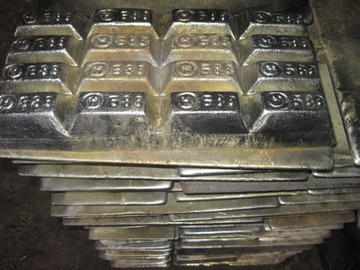- Mainpage
- Directory
- Non-ferrous metals
- Babbit, solder, tin
Babbitt the Tin

general characteristics
Babbits are antifriction fusible alloys, the basis of which is lead and tin. They represent a group of low-melting alloys with a low coefficient of friction. The melting point ranges from 300 to 440 ° C. Their name is due to the American inventor Isaac Babbit. The main purpose — to ensure uniform fit in the form of a layer, filled or sprayed on the bearing shell of the bearing. Subdivided into:
— tin B83, B88, BV3S (based on tin, copper and antimony);
— lead BN, B16, BSB (lead, copper, antimony and tin);
— Calcium BK2, BKA, BK2Sh (lead, sodium and calcium).
Advantages
Reduce considerably the wear of moving parts, which contributes to the durability of the equipment. The thickness of the babbitt layer applied to the steel liner determines the reliability of the sliding bearings. Characterized by rapid adhesion to the surface of the shaft, have a high plasticity and the ability to retain lubricants. This is achieved through a heterogeneous structure of babbits, in the soft basis of which there are solid particles. The principle of operation is as follows: a rotating shaft rests on solid particles capable of withstanding a high specific pressure, and the soft base wears out more quickly, is worked on to the shaft and forms a microrelief that keeps the lubricant.
disadvantages
All without exception babbits have one drawback — a very low fatigue resistance, which significantly worsens the performance of the bearing. Babbits are successfully used in bearings having a steel or bronze body. The thickness of the babbitt layer, poured on the steel liner, significantly affects the duration of the bearings — reducing the thickness of the layer extends the service life of the bearing.
Using
The most popular variants of the alloy are:
10% copper, 90% tin;
7% antimony, 4% copper, 7% antimony, 89% tin;
15% of antimony, 5% of tin, 15% of antimony, 80% of lead;
As additives are used: copper, antimony, arsenic, nickel, cadmium, tellurium, sodium, calcium, magnesium. To increase the viscosity and achieve a minimum coefficient of friction, tin babbits are used, which have thermal conductivity, wear resistance and high corrosion resistance. Roller babbits are used for rolling mill bearings and diesel engines, characterized by a higher operating temperature. In bearings of the rolling stock of railway transport, lead- calcium calcium babbits are used. Calcium alloys can be doped with other elements. Zinc alloys are used to produce cast billets and various shaped parts by injection molding. Based on them, bearing solders and alloys are produced.
Melting of alloys on the basis of the above elements is not difficult, but the various components that make up their composition make it difficult to coordinate a single technological process of melting. On this basis, the technological process is developed separately for each component.
Buy at a bargain price
The company Avek Global offers the most optimal prices for the implementation of low-melting alloys. Prices are formed taking into account technological features of production, additional costs are not included. We offer excellent purchasing conditions for retail customers, as well as for large-scale productions. To get acquainted with the catalog of products, see our price list and get the necessary information you can on our website. Online consultant is always at your service and will answer all your questions. We are waiting for your orders, avglob.org — the Internet address of the company in the contacts section.


